We are just back from a trip to the Finger Lakes to remove our things from the lakehouse while the damage from the flood is repaired. We hope we will be able to return by spring, which is such a beautiful time in that region and, for the purposes of this newsletter, the beginning of farmers’ market season. This week, I welcome Top Chef judge and generally wonderful human being Gail Simmons to my What’s Burning podcast. Have a listen. Fry some schnitzel. Enjoy.—Mitchell
To the children of our close friends, the Gottliebs, I am known as “Uncle Schnitzel,” which rhymes with Mitchell. But the truth is that Uncle Nate is the real schnitzel-nik in our family.
As you know, if you’ve been following along with this newsletter and my Instagram feed, we have been spending a lot of time up in the Finger Lakes, where I went to college and where Nate and I got married. That joyous, legal event happened in 2012 at Dano’s Heuriger, a Viennese-style winery restaurant situated among the vineyards on Seneca Lake. At the time, Dano’s was the domain of our dear friends Dano Hutnik, who was chef, and his wife Karen Gilman, who was both pastry chef and general manager. Although Dano died suddenly in 2018, Karen, who is also an accomplished visual artist, has continued to operate the restaurant, surviving the COVID shutdown and the subsequent labor shortage that hit rural New York State particularly hard.
A heuriger is like a wine-country bistro that serves traditional Vienese food and young vintages of local wine. To start, Dano’s offers a selection of spreads, such as Liptauer (see Issue #52), walnut horseradish, and pumpkin seed oil on rustic breads, and salads, such as beet with horseradish and celery root remoulade. Think of them as Vienese meze. Of the many things that follow, smoked pork, sausages, sauerkraut, and spatzle are de rigueur. But no matter how many times we have eaten at Dano’s, and that is many, and no matter how many enticing specials they have, which might include mushroom strudel, Szegediner goulash, or roast pork, Nate always orders the Wiener schnitzel.
This mono-gastronomic behavior of Nate’s is not unique to Dano’s. When I lived in Milan in 2015, we would often eat out at a couple of favorite places, namely Latteria San Marco and Cantina Piemontese. If coteletta alla Milanese, the Italian equivalent of Weiner schnitzel, was ever on either menu, Nate always ordered it.
Cotoletta alla Milanese, literally Milan-style cutlet, is considered by some to be the source of Weiner schnitzel, Vienna-style cutlet. An Austrian general is said to have encountered his first pounded veal, breaded and fried, during a battle in the late 19th century. Upon his return to Vienna, he implored his cook to recreate it. Culinary historians doubt the veracity of this story, noting the use of breadcrumbs for coatings in Teutonic and other cookbooks dating at least a century earlier. Still, both Milan and Vienna are known for their very fine breaded veal cutlets, which share key characteristics‚ the very same ones employed by Karen just last weekend, when we were staying at her home and she showed me how she makes Nate’s favorite entrée at Dano’s.
First, the Weiner schnitzel must be made from veal. This is literally the law in Austria, where Wiener schnitzel is considered a national dish, with its own festival day (September 9) and a never-ending competition among cooks for whose is best. By law, schnitzel made from pork must be indicated on menus as Wiener schnitzel vom Schwein, or “from pork.”
Here I will interject a family story. Both sides of my family are Jewish; my father came from an Orthodox home in Brooklyn, my mother, from a not particularly observant family in New Jersey. Although they didn’t keep kosher, things like pork, shellfish, and milk with meat were nevertheless verboten at my mother’s home. Apparently, during the Second World War, when meat was rationed, Weiner schnitzel made from pork, which was easier to come by than veal, was secretly served. Illegal in more ways than one. I think many ballaboostas of the era have similar stories to tell.

Another aside, “schnitzel” is also considered an unofficial national dish of Israel, where the term always refers to breaded chicken cutlets. (There isn’t a law there, yet, beyond kashrut, which allows for veal from the front end of the cow.) In fact, when I was doing some visioning work at Asif: Culinary Institute of Israel, several members of the team suggested schnitzel in a pita was the most iconic Israeli dish, representing the confluence of Ashkenazi and Mizrahi culinary traditions in a sandwich.
Anyway, back to Karen’s schnitzel. The cut of veal is important. Top round or eye of the round, which are a little tough, and therefore flavorful, and quite lean are best for schnitzel. Shoulder can be used in a pinch. The palatability is enhanced by slicing the cutlets across the grain of the muscle and then pounding them thin, producing a tender, flavorful schnitzel.
Next, the classic breading technique is deployed. The pounded veal is dredged in seasoned flour, dipped in egg wash, and coated in fine, toasted bread crumbs. Don’t be using Japanese panko for your schnitzel, which would surely produce a delicious, but controversial cutlet.
Although I am prone to pan-frying in shallow oil, a proper schnitzel needs to float in hot fat, enough to deep fry, as it were. The choice of fat also has an impact. Karen uses a blended vegetable oil. I generally use peanut. And my favorite Milanese cutlets were no doubt fried in some combination that included butter, the rich aroma of which always reaches the table at Cantina Piemontese before the schnitzel itself. You can fry a thinly pounded schnitzel in about a ½ inch of oil and/or clarified butter in a wide pan. But, as Karen advises, you have to cook just one at a time, and just before serving, to produce the best result. You can keep the schnitzel warm on a rack or paper-towel lined tray in a 200°F. oven for 15 to 20 minutes, if you must.
One characteristic quality of a good schnitzel is that the breading forms pockets across the surface that crisp in the hot fat. This is one of the reasons fine breadcrumbs and deep oil are recommended. To achieve this effect, it also is important to make sure your oil is properly heated to about 375°F before the first schnitzel is fried and then reheated adequately between schnitzels.
A note about veal. Over the last few decades there has been tremendous push back against eating veal, the campaign against it deriving from the mistreatment of animals to produce so-called “milk-fed” veal that is valued by some for its pale color, delicate flavor, and tenderness. I have no interest in the meat of these anemic calves and would never support the torture of animals to attain it. I also respect those who choose not to eat meat or animal products of any kind, whether for ethical or environmental reasons. But veal, the meat from the young, male calves produced by the dairy industry but of no use to it—recall that only female cows produce milk—need to be either eaten or destroyed. The latter seems wasteful and problematic to me if we are going to consume dairy products, which I do. So, I have no problem consuming local, pasture-raised veal. I suggest you investigate for yourself to come to your own conclusions, and if you decide to consume veal, find a source you trust. Otherwise, there is always pork and chicken. A slab of steamed celeriac also makes a nice schnitzel.
RECIPE: Karen’s Weiner Schnitzel
Four 3- or 4-ounce cutlets of veal, thinly sliced across the grain from the top round, eye of the round, or shoulder, butterflied if necessary to make it thin
1 cup all-purpose flour
1 tablespoon fine sea salt
1 teaspoon freshly ground black pepper
2 eggs
3 tablespoons milk or cream
About 2 cups fine, toasted breadcrumbs, not Italian or seasoned in anyway
2 to 3 cups vegetable, peanut, or other neutral oil
¼ cup or more clarified butter or ghee (optional)
1 lemon, cut into wedges
Lay a piece of plastic film on a clean, sturdy work surface and lay out the first veal cutlet on top of that. Using a meat mallet or the bottom of a small, heavy frying pan, pound the veal until very thin, less than ¼-inch, and wide. Be careful not to break through the fibers and create holes in the flesh, but don’t be gentle, either. You want to pound the veal until it is 2 or 3 times the surface area of the original cutlet and very thin. Set aside and repeat with the remaining veal cutlets.

Place the flour on a large plate and season with the salt and pepper. In a wide bowl, beat the eggs with the milk or cream and about a tablespoon of water until blended. Finally, spread the breadcrumbs out on a large tray or platter. Dredge the first pounded schnitzel in the seasoned flour, tapping off any excess. Place it in the bowl with the beaten egg mixture and slowly lift it up to let any excess egg drain before you lay it out on the bread crumbs. Tap the schnitzel to ensure the bread crumbs stick, then flip and make sure the entire surface is evenly covered. You don’t want to press the crumbs too firmly into the meat because you want those pockets to form while frying. Set the breaded schnitzel on a clean tray. Wash your hands and repeat with the remaining three schnitzel.
Preheat the oven to 200°F. Pour the oil into a wide, deep frying pan, about ½ inch deep. Add the clarified butter, if using. Turn on the burner to medium and slowly bring the fat up to 370°F. Once it gets there, you can lay the first schnitzel in the pan. It should sizzle visibly and audibly around the entire edge of the cutlet. Let it cook for about 3 or 4 minutes until browned. Modulate the heat, if necessary, to keep a steady temperature. When browned, use tongs to flip the schnitzel, being careful not spill any hot oil. Cook the second side another 3 minutes or so. The first side cooked, now facing up, should look appetizingly uneven. When the schnitzel is done. Set it on a clean baking try (you can use a wire rack if you like) and place in the preheated oven while you fry the rest.
When all the schnitzel are fried, arrange them on a serving plate or on individual dinner plates, along with a wedge or two of lemon. Call Nate from the couch and tell him dinner is ready.




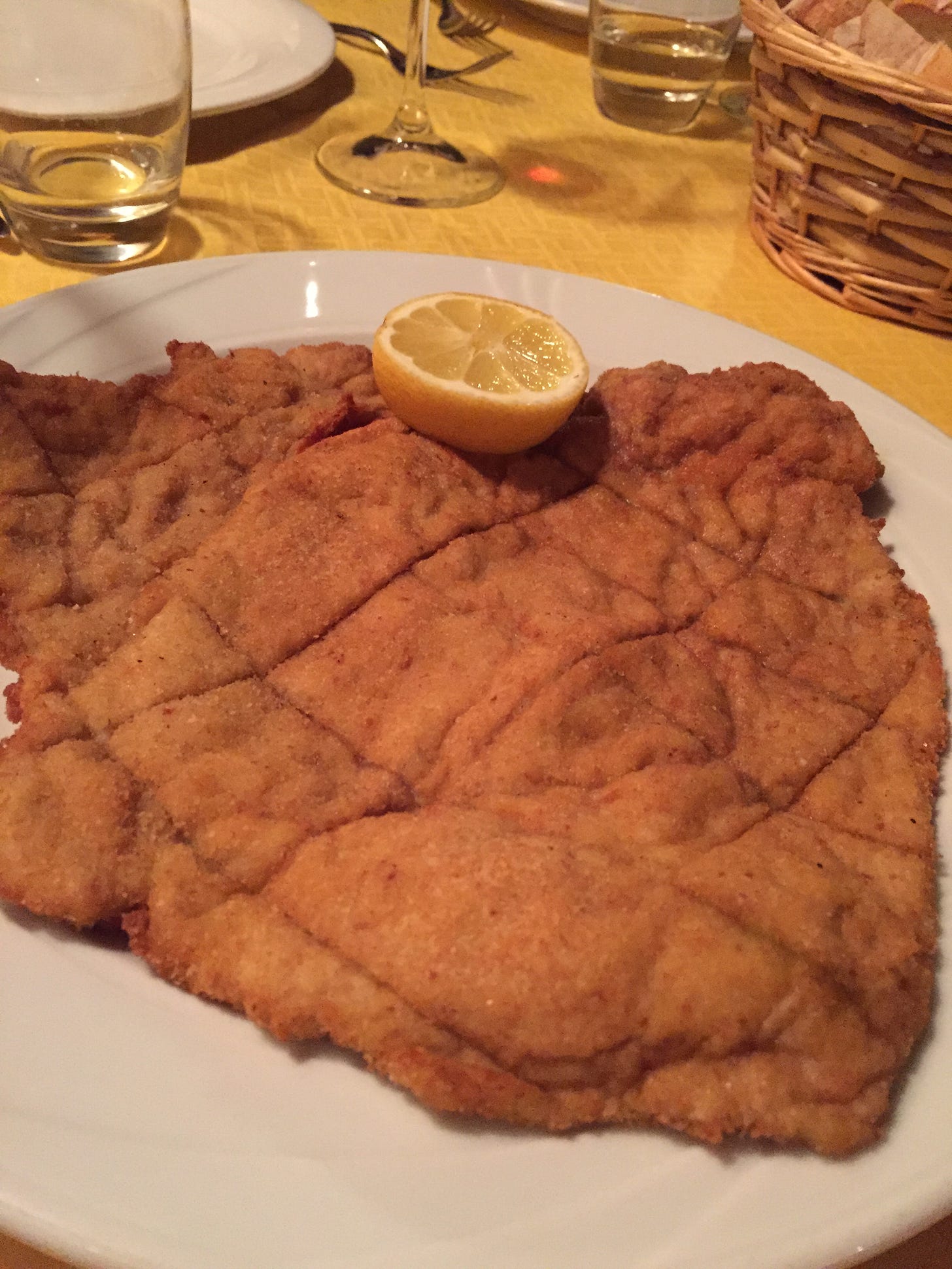

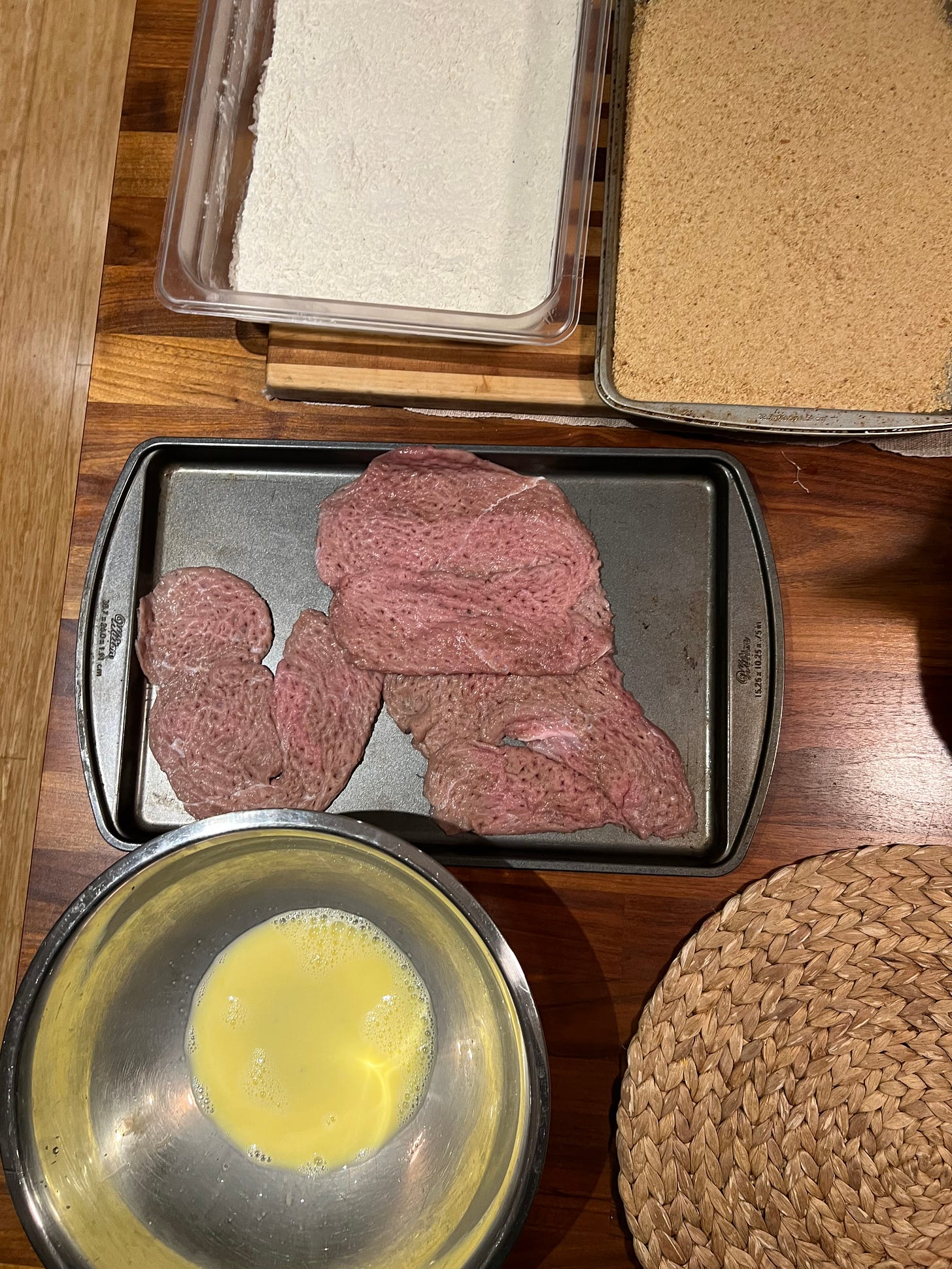
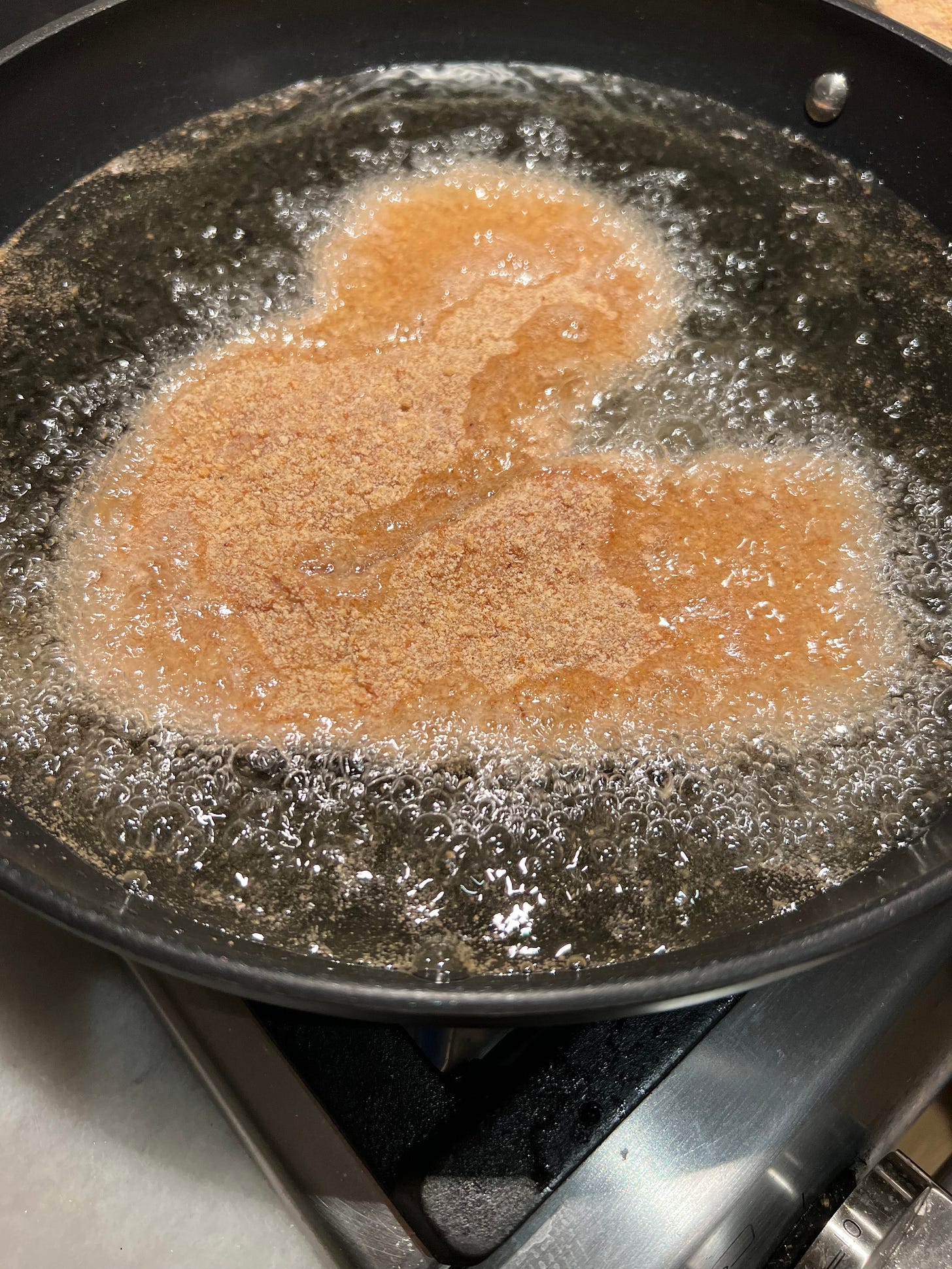
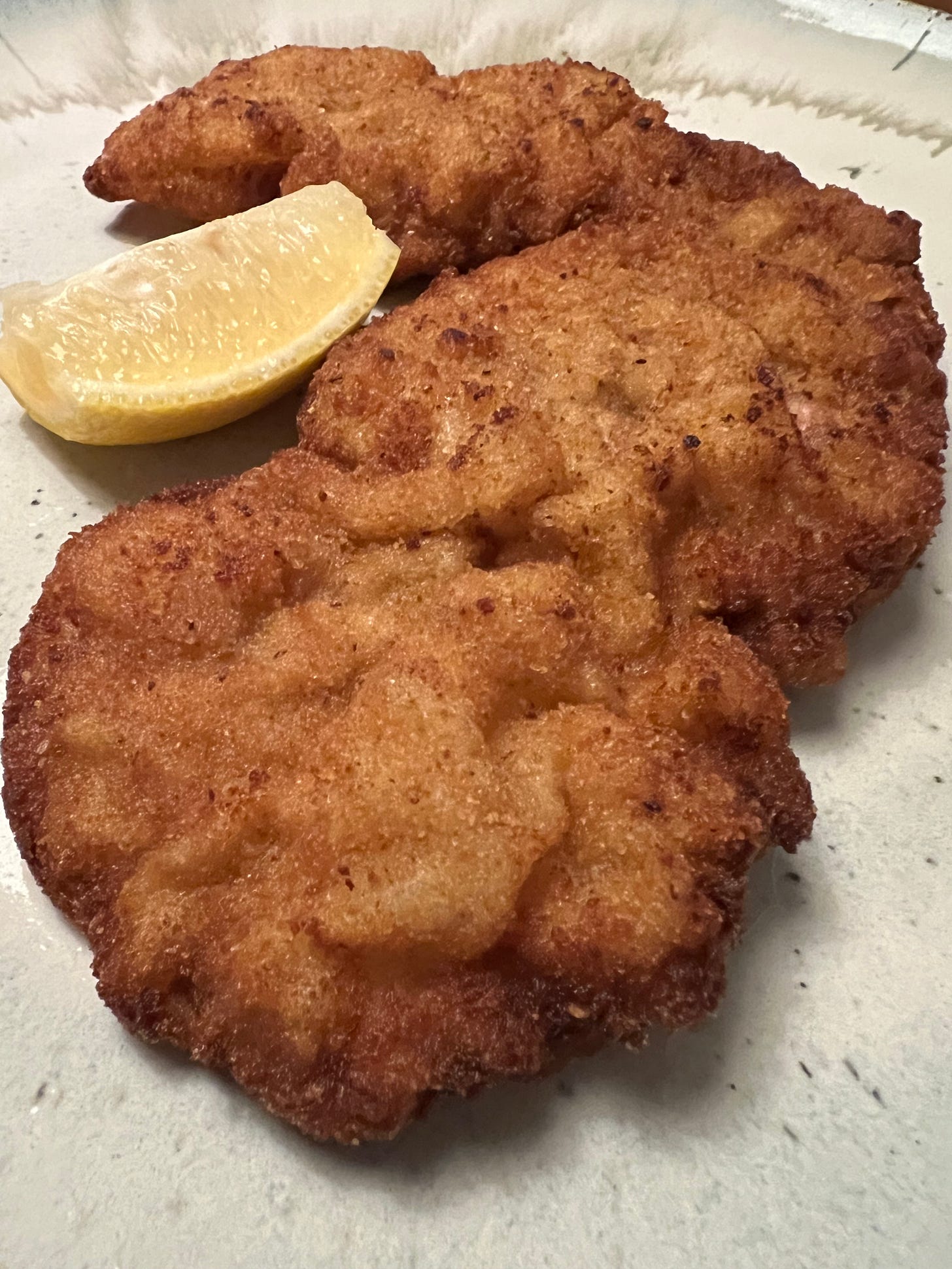

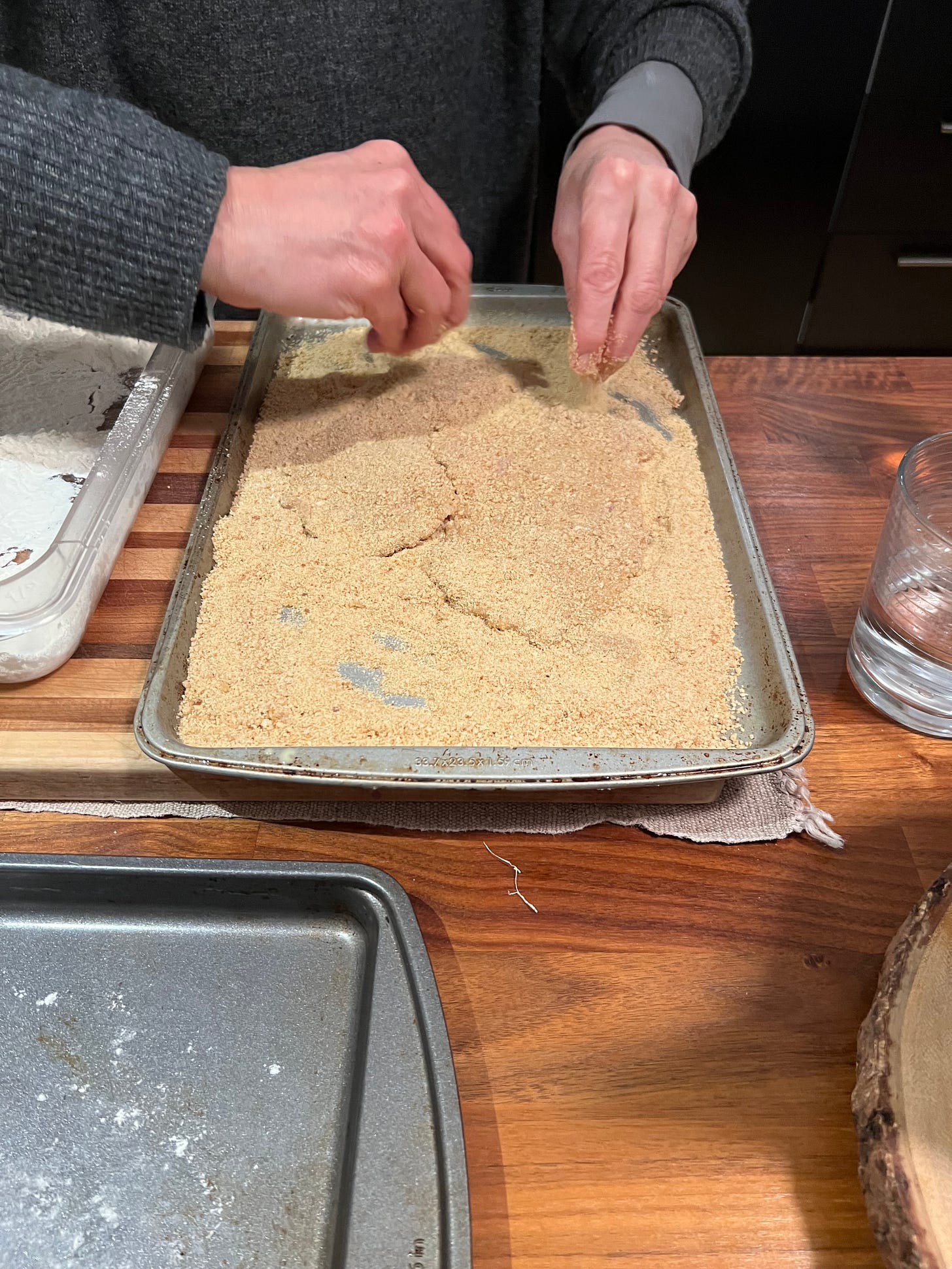

I loved this post, so full of information of all kinds. Next time Dr. Nate comes to Maine, be sure to let Sara know in advance and she'll make him her Milanese.